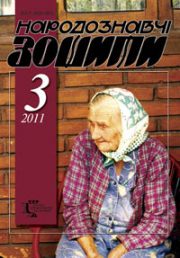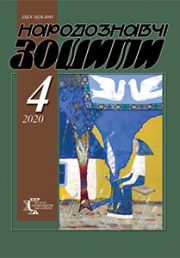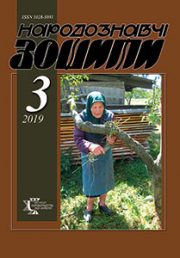The Ethnology Notebooks. 2019, № 3 (147), 732—748
UDK 39(=161.2)[643:747](477.83/.87)
DOI https://doi.org/10.15407/nz2019.03.732
SYVAK Vasyl
ORCID ID: https://orcid.org/0000-0002-6444-0705
Ph.D. of Sciences in History, Researcher of the Institute
of Ethnology of the National Academy of Sciences
of Ukraine, in the Department of Historical Ethnology,
15, Svobody Avenue, 79000, Lviv, Ukraine.
Contacts: e-mail: suvakvasul@gmail.com
Abstract. An interior is integral part of the national housing of the Ukrainian Carpathians, the main contents of which are: heating system, arrangement (furniture), lighting, equipment, decorative objects and applied arts. In the study of history of the development of traditional furniture of the traditional housing of the Ukrainian Carpathians, the question is raised about the ethnic peculiarity of the phenomenon and the external influences on it. The article deals with varieties of equipment for dwellings and auxiliary premises (pantries (komora) and porch (siny) that were mounted in the zone of use of the upper space. I conditionally divide them into two kinds. To the first, stationary, originally belonged to two parallel located poles, which the Ukrainian highlanders meant «hriady». To the second, semi-stationary, belonged to the janitors, which were also sometimes termed as «hriady». Both adaptations belonged to the most ancient parts of the house. They have been living for centuries, so finding out the origin and function of equipment in various ethnographic districts of the Ukrainian Carpathians is very relevant.
The proposed exploration aims to trace the use of built-in and semi-built equipment in the smoky («kurnyi») and semi-smoky («napivkurnui») housing of the Ukrainian highlanders, to find out their common and local features. The object of the research is the traditional habitation of Boikos, Hutsuls and Lemkos, and the subject is the built-in and semi-built equipment in the zone of use of the upper space. The methodological basis of the study was the general scientific principles of historicism, systemicity, scientific objectivity, which allowed to carry out the necessary scientific analysis of the subject under the study as a whole, as well as its individual aspects. They made it possible to systematize collected material, to trace the evolutionary processes that took place in the equipment of the interior of the Ukrainian Carpathians in the late nineteenth and first half of the twentieth century. The indicated problem was not a separate object of the research in the past. The source base was formed with the help of stationary and route ethnographic expeditions, during which the fixation of field materials was made by means of taking photographs, measuring, painting objects, interviewing the respondents, therefore the author’s field materials are the basis of the work.
Built-in and semi-built equipment of the Ukrainian-mountaineers functioned at the same time as the construction of a smoky house. I believe that terminology, as well as adaptations, were introduced to the Carpathians even during their settlement, from the fifteenth century, or, more precisely, when they built a full-fledged dense housing.
Keywords: Ukrainian Carpathians, equipment, «hriadka», «zherdka», smoky and semi-smoky hose («kurna ta napivkurna khata»), heating «by-clean» («po-chystomu»), «khata», «siny», «komora».
Received 7.05.2019
REFERENCES
Syvak, V. (2017). The interior furnishings of the national housing of Ukrainian Carpathians: the level of scientific problem development. The Ethnology Notebooks, 3, 633–646 [in Ukrainian].
Zubrytsky, M. (1909). Peasant houses in Mshantsy, Staromisky district. In Materials for the Ukrainian-Ruthenian ethnology (Vol. II, pp. 1—22). Lviv [in Ukrainian].
Beskyd, Y. (1972). Material culture of Lemkivshchyna. Toronto [in Ukrainian].
Franko, I. (1985). Ethnographic Exhibition in Ternopil. In Franko, I. Collected Works: in 50 vols (Vol. 46, pp. 469–479). Kyiv: Naukova Dumka [in Ukrainian].
Falkovsky, Ya. (1935). The village of Volosate Lissky district. In Chronicle of Boykivshchyna (Vol. 5, pp. 14–28). Sambir [in Ukrainian].
Reinfuss, R. (1977). Folk furniture in Poland. Wroclaw [in Polish].
Moszynski, K. (1929). Kultura materjalna. In Kultura ludowa slowian (Cz. 1). Krakow [in Polish].
Kepa, E.(1971). Residential interiors in Lemko region in the 19th and 20th centuries. Materials of the Folk Architecture Museum in Sanok (Vol. 13, pp. 21–32). Sanok [in Polish].
Shukhevych, V. (1899). Huzulschyna. Part 1. Materials for the Ukrainian-Ruthenian ethnology (Vol. II). Lviv [in Ukrainian].
Sopolyha, M. (1983). National Housing of Ukrainians of Eastern Slovakia. Bratislava [in Ukrainian].
Sopolyha, M. (2012). Traditional folk furniture of Ukrainians in Slovakia. Lemkowie, bojkowie, rusini – historia, wspolczesnosc, kultura materialna i duchowna (Vol. IV, part. 2, pp. 613–623). Slupsk [in Ukrainian].
Syvak, V. (1989). Field ethnographic materials on the theme «The interior of the folk housing», collected in Staryi Sambir and Turka district of the Lviv region. In Archive of the Institute of Ethnology of the National Academy of Sciences of Ukraine. F. 1. Op. 2. Od. save 359. Note. 3. 49 arcs [in Ukrainian].
Syvak, V. (2007). Field ethnographic materials on the theme «The interior of the folk housing», collected in Staryi Sambir district of the Lviv region. 2007. In Archive of the Institute of Ethnology of the National Academy of Sciences of Ukraine. F. 1. Op. 2. Od. save 359. Note. 4. 71 arcs [in Ukrainian].
Syvak, V. (1990). Field ethnographic materials on the theme «The interior of the folk housing», collected in Ivano-Frankivsk region. In Archive of the Institute of Ethnology of the National Academy of Sciences of Ukraine. F. 1. Op. 2. Od. save 364. 62 arcs [in Ukrainian].
Syvak, V. (1991). Field ethnographic materials on the theme «The interior of the folk housing», collected in Staryi Sambir and Turka district of the Lviv region and Velykyi Bereznyi district of the Transcarpathian region. In Archive of the Institute of Ethnology of the National Academy of Sciences of Ukraine. F. 1. Op. 2. Od. save 367. Note. 1. 92 arcs [in Ukrainian].
Syvak, V. (1991). Field ethnographic materials on the theme «The interior of the folk housing» , collected in Perechyn district of the Transcarpathian region. In Archive of the Institute of Ethnology of the National Academy of Sciences of Ukraine. F. 1. Op. 2. Od. save 367. Note. 2. 92 arcs [in Ukrainian].
Sreznevsky, I. I. (1912). Materials for the Dictionary of ancient russian language on written monuments (Vol. 3). St. Petersburg [in Russian].
Blomqvist, E. (1956). Peasant built Russian, Ukrainians and Belarusians (settlements, dwellings and farm buildings). Proceedings of the Institute of Ethnography of the USSR Academy of Sciences (Vol. 31). Moscow [in Russian].
Grinchenko, B. (1907). Dictionary of the Ukrainian language. Kiev [in Russian].
Sopolyha, M. (1983). Slovnik of dialectical ethnographic terms. National Housing of Ukrainians of Eastern Slovakia (pp. 284–297). Bratislava [in Ukrainian].
Radovich, R. (2015). Slovnik of the folk architectural terminology. National architecture Staryi Sambir district in the nineteenth – first half of the twentieth century (housing and economic complex) (pp. 295–333). Kiev [in Ukrainian].
Syvak, V. (2018). Field ethnographic materials on the theme «The interior of the folk housing», collected in Skole district of the Lviv region. In Archive of the Institute of Ethnology of the National Academy of Sciences of Ukraine. F. 1. Op. 2. Od. save 902. 36 arcs [in Ukrainian].
Syvak, V. (1994). Field ethnographic materials on the theme «The interior of the folk housing», collected in Skole, Turka district of the Lviv region and Volovets, Mizhgirya district of the Transcarpathian region. In Archive of the Institute of Ethnology of the National Academy of Sciences of Ukraine. F. 1. Op. 2. Od. Save 359. 78 arcs [in Ukrainian].
Syvak, V. (1986). Field ethnographic materials on the theme «The interior of the folk housing», collected in Lviv and Transcarpathian region. In Archive of the Institute of Ethnology of the National Academy of Sciences of Ukraine. F. 1. Op. 2. Od. Save 359. Note. 1. 65 arcs [in Ukrainian].
Zubrytsky, M. (1895). Village of Kindrativ (Turka district). Zhytye i slovo: the bulletin of literature, history and folklore (Vol. 4, pp. 216–230). Lviv [in Ukrainian].
Kobilnik, B. (1937). Material culture of the village of Zhukotin in the Turka district. In Chronicle of Boykivshchyna (pp. 61–62). Sambir [in Ukrainian].
Goshko, Yu. (1976). Population of the Ukrainian Carpathians of the XVth – ХVІІІ centuries. Settlement. Migration. Everyday life. Kyiv: Naukova dumka [in Ukrainian].
Franko, I. (1985). My father’s house. In Franko, I. Collected Works: in 50 vols (Vol. 39, pp. 243–247). Kyiv: Naukova Dumka [in Ukrainian].
Syvak, V. (1996). Field ethnographic materials on the theme «The interior of the folk housing», collected in Kiev and Zhitomir region. In Archive of the Institute of Ethnology of the National Academy of Sciences of Ukraine. F. 1. Op. 2. Od. Save 426. Note. 1. 93 arcs [in Ukrainian].
Radovich, R. (2017). Polissya dwelling: cultural and genetic origins and evolutionary processes. Lviv [in Ukrainian].
Boychenko, V. (2003). Brief ethnographic information about village Polytsi Kamin-Kashirsky district of the Volyn region of the late XIX – early XX century. Ethnocultural heritage of Rivne Polissya (Issue 4, pp. 64–98). Rivne: Perspective [in Ukrainian].
Boychenko, V. (2005). Information about the village Bilovizh Rokytne district of Rivne region (late XIX – early XX century.). Ethnocultural heritage of Polissya (Issue 6, pp. 143–188). Rivne: Perspective [in Ukrainian].
Svyryda, R. (1979). Equipment traditional dwelling right-bank Polissya. Folk art and ethnography, 3, 56–63 [in Ukrainian].
Syvak, V. (2007). Zherdka. In Small Encyclopedia of Ukrainian Ethnography (pp. 203–204). Lviv [in Ukrainian].
Hayova, E. (2014). Characteristic features of equipment for residential and commercial buildings in Verkhovyna district of Ivano-Frankivsk region. Folk art and ethnology, 1, 108–116 [in Ukrainian].
Syvak, V. (2007). Field ethnographic materials on the theme «The interior of the folk housing», collected in Staryi Sambir district of the Lviv region. 2002. In Archive of the Institute of Ethnology of the National Academy of Sciences of Ukraine. F. 1. Op. 2. Od. save 359. Note. 3. 89 arcs [in Ukrainian].
Syvak, V. (1997). Field ethnographic materials on the theme «The interior of the folk housing», collected in Gorodenka, Tysmenytsia and Tlumach district of Ivano-Frankivsk region, Zastavna district of Chernivtsi region. Ethnology of the National Academy of Sciences of Ukraine. F. 1. Op. 2. Od. save 367. Note. 3. 87 arcs [in Ukrainian].
Syvak, V. (2003). Interior polis’ky housing. In Polissya of Ukraine: materials of historical and ethnographic research (Vol. 3, pp. 125–126). Lviv [in Ukrainian].
Serhachov, S. A. (1989). Zherdka. In Ethnography of Byelorussia. Encyclopedia (pp. 199–200). Minsk [in Byelorussia].
Stoyka, D. (1984). House and farm of the romanian peasant. Bucharest: Meridians [in Russian].
Gyozo, S. (1986). Famuvesseg. Budapest: Agricultural Publishing House [in Hungarian].






